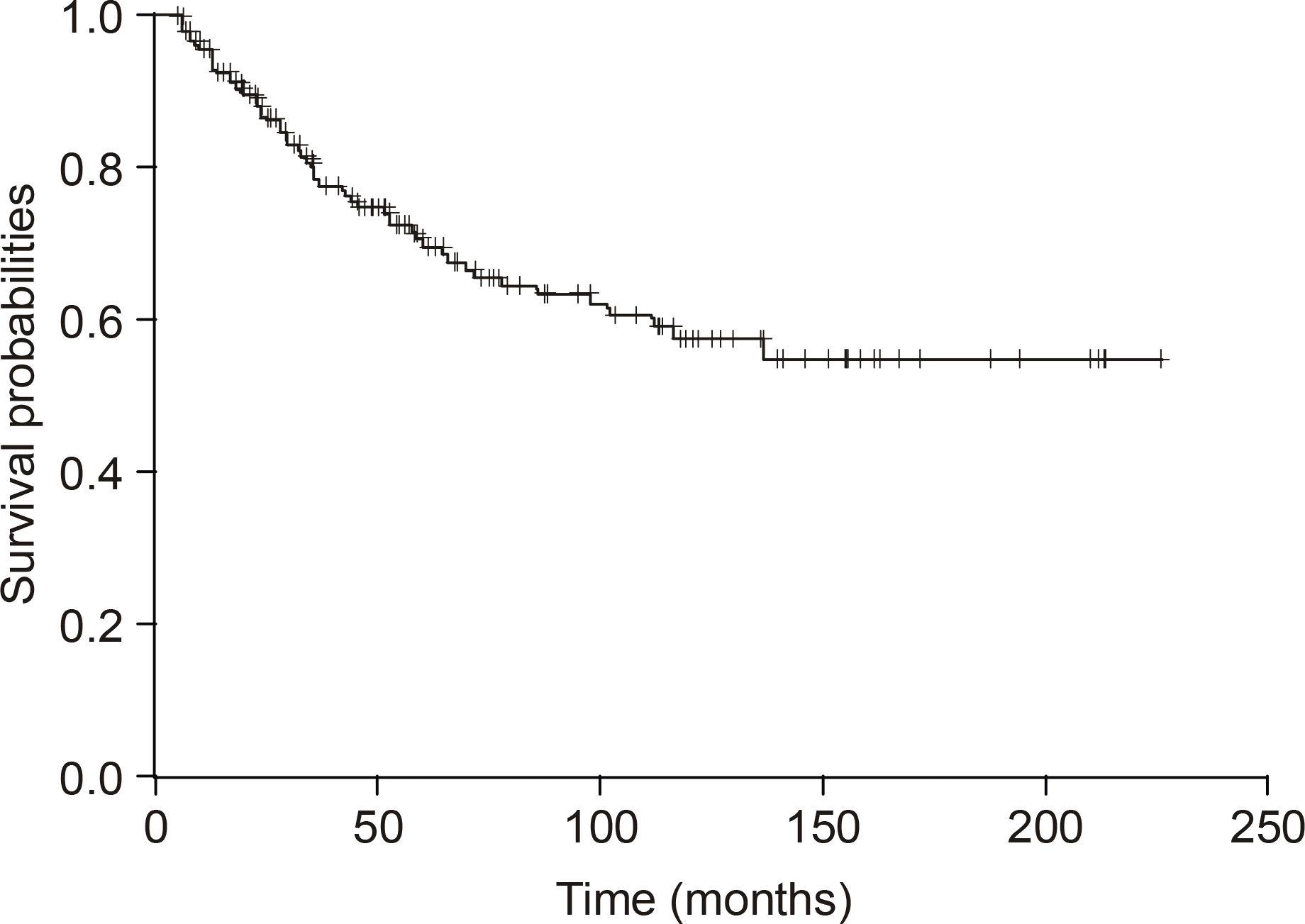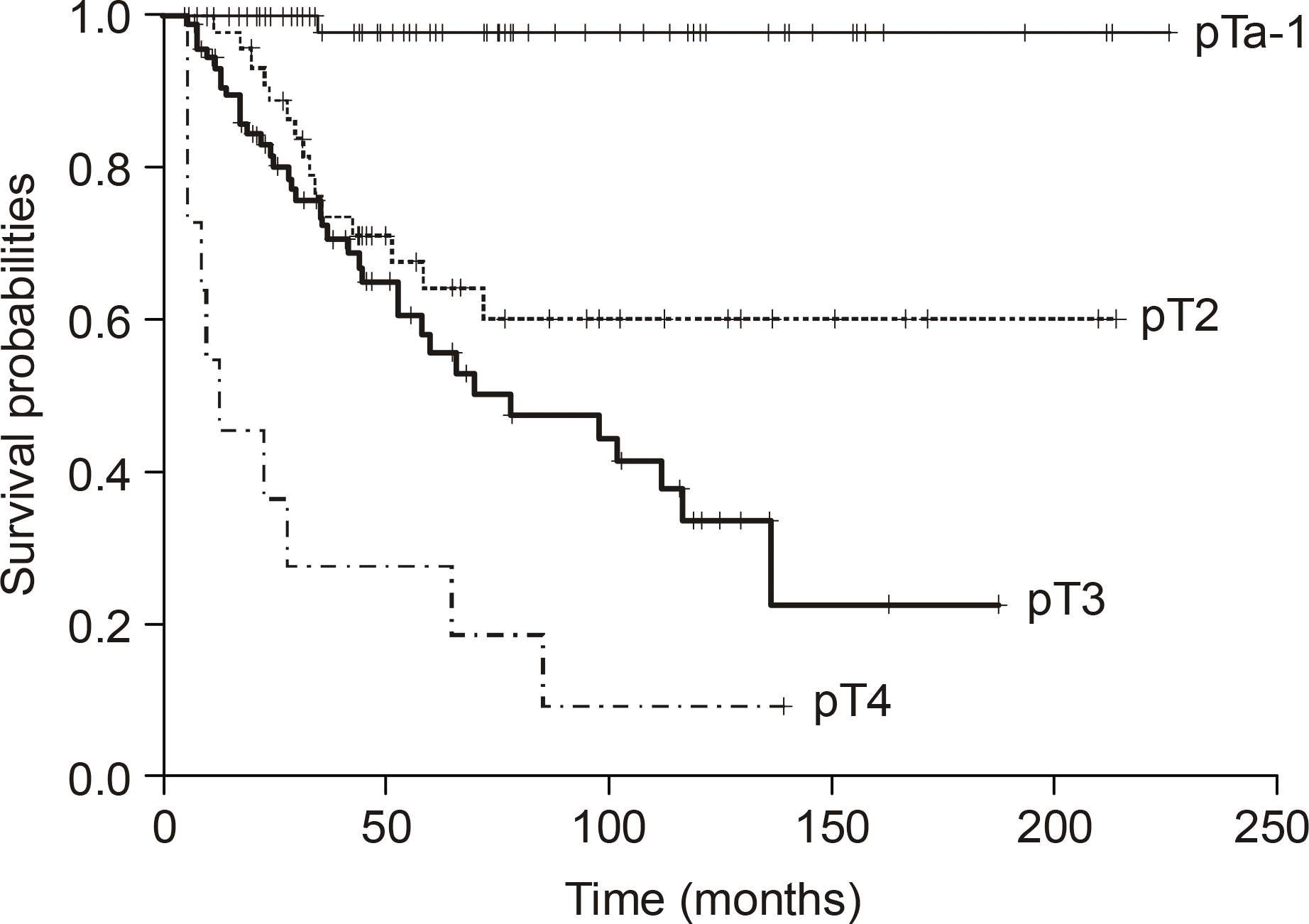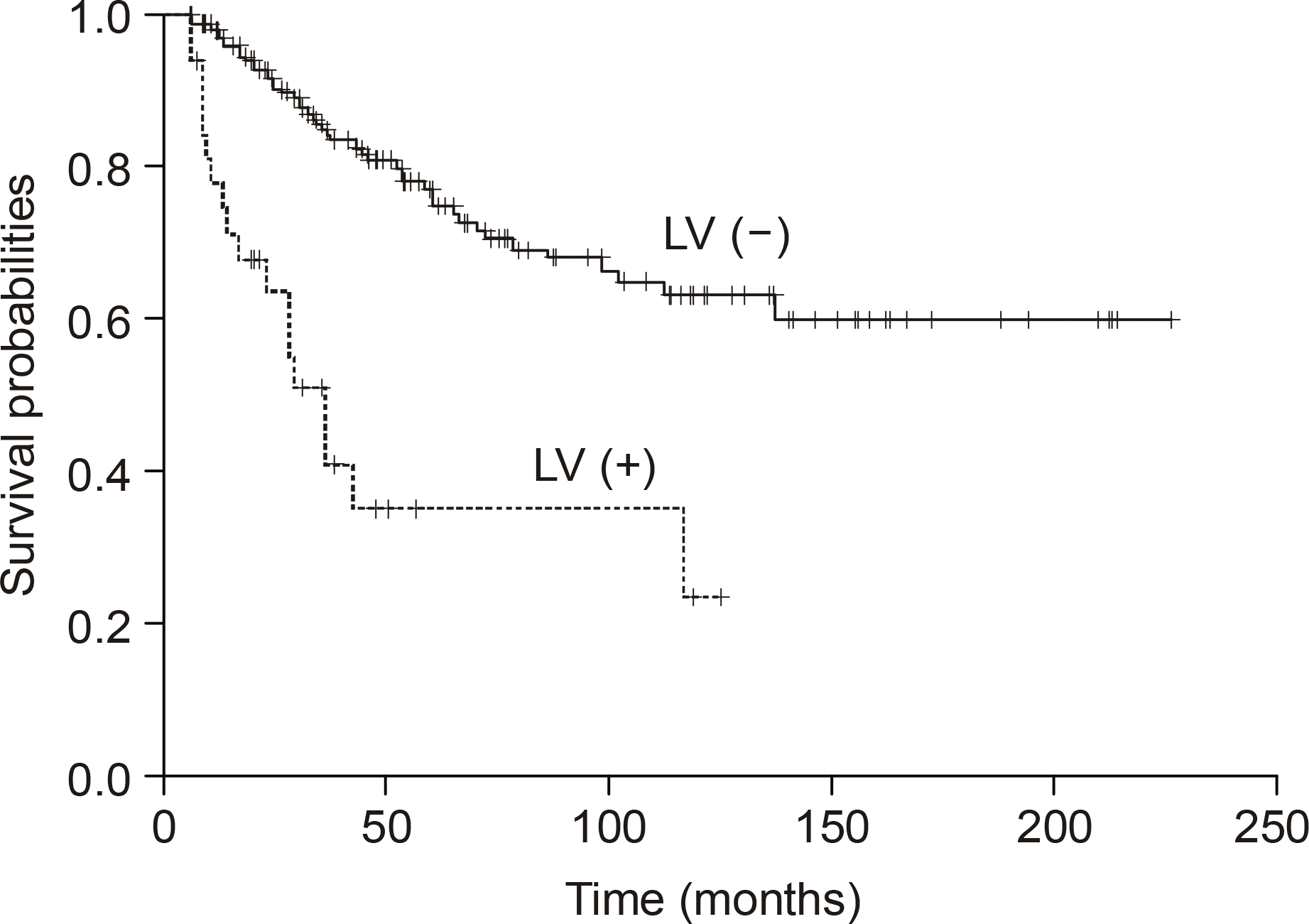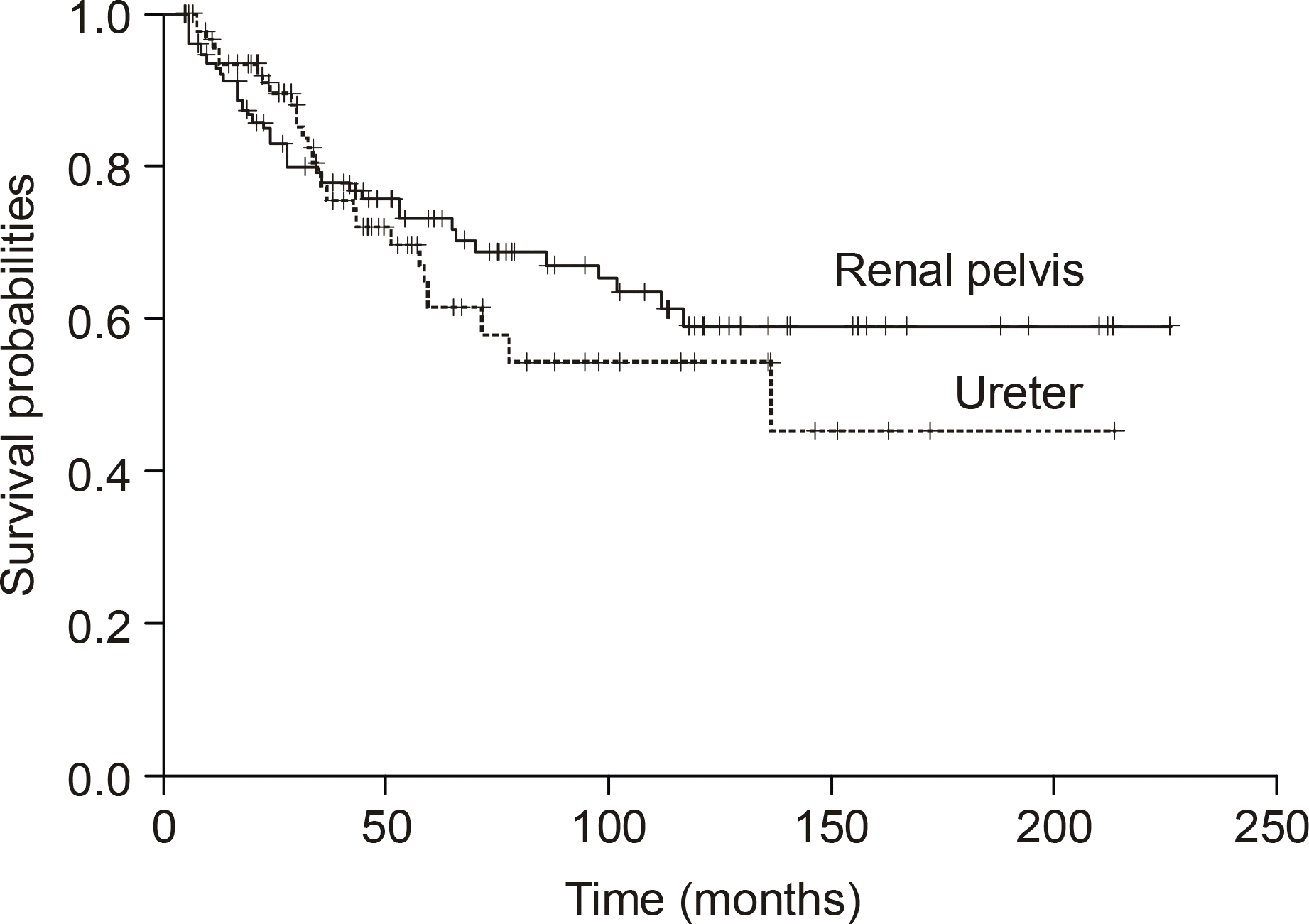Abstract
Purpose:
We evaluated the pattern of recurrence and the prognostic factors for patients who suffered with upper urinary tract transitional cell carcinoma (TCCa) and were surgically treated.
Materials and Methods:
Between 1986 and 2003, the medical records on 228 patients who were diagnosed and surgically treated for upper urinary tract TCCa were retrospectively analyzed with regard to the pattern of recurrence and the prognostic factors. The main site of the tumors was the renal pelvis in 127 patients and the ureter in 101 patients. Nephro- ureterectomy and/or bladder cuff resection was performed on 215 patients and conservative surgery was performed on 13 patients, respectively.
Results:
Recurrence developed in 75 patients (32.9%) and the mean time to recurrence was 23.9 months (3-120). Of these 75 patients, locoregional recurrence without metastasis occurred in 28.0%, locoregional recurrence with metastasis occurred in 25.3%, metastasis without locoregional recurrence occurred in 42.7% and contralateral upper tract recurrence occurred in 4%. There was no difference between the renal pelvic cancer and ureteral cancer regarding the pattern of recurrence. Meanwhile, 5-year recurrence-free and disease-specific survival rates were 63.9% and 69.7%, respectively. On univariate analysis, the T stage, tumor grade, lympho- vascular permeation, margin status and nodal status had a significant influence on recurrence-free survival and disease-specific survival. On multivariate analysis, the T stage and lymphovascular permeation were independent prognostic factors for upper urinary tract TCCa.
Go to : 
REFERENCES
2.Hall MC., Womack S., Sagalowsky AI., Carmody T., Erickstad MD., Roehrbom CG. Prognostic factors, recurrence, and survival in transitional cell carcinoma of the upper urinary tract: a 30-year experience in 252 patients. Urology. 1998. 52:594–601.

3.Murphy DM., Zincke H., Furlow WL. Primary grade 1 transitional cell carcinoma of the renal pelvis and ureter J Urol. 1980. 123:629–31.
5.Anderstrom C., Johansson SL., Pettersson S., Wahlqvist L. Carcinoma of the ureter: a clinicopa仕Lologic study of 49 cases. J Urol. 1989. 142:280–3.
6.Cozad SC., Smalley SR., Austenfeld M., Noble M., Jennings S., Raymond R. Transitional cell carcinoma of the renal pelvis or ureter: patterns of failure. Urology. 1995. 46:796–800.

7.Coirado F., Ferri C., Mannini D., Corrado G., Bertoni F., Bacchini P, et al. Transitional cell carcinoma of the upper urinary tract: evaluation of prognostic factors by histopathology and flow cytometric analysis. J Urol. 1991. 145:1159–63.
8.Miyake H., Hara I., Gohji K., Arakawa S., Kamidono S. The significance of lymphadenectomy in transitional cell carcinoma of the upper urinary tract. Br J Urol. 1998. 82:494–8.

9.Ozsahin M., Zouhair A., Villa S., Storme G., Chauvet B., Taus-sky D, et al. Prognostic factors in urothelial renal pelvis and ureter tumours: a multicentre Rare Cancer Network study. Eur J Cancer. 1999. 35:738–43.

10.Park SC., Hong BS., Kim CS., Ahn HJ. The impact of tumor location on prognosis of transitional cell carcinoma of the upper urinary tract. J Urol. 2004. 171:621–5.

11.Mellemgaard A., Carstensen B., Norgaard N., Knudsen JB., Olsen JH. Trends in the incidence of cancer of the kidney, pelvis, ureter and bladder in Denmark 1943-88. Scand J Urol Nephrol. 1993. 27:327–32.

12.Munoz JJ., Ellison LM. Upper tract urothelial neoplasms: incidence and survival during the last 2 decades. J Urol. 2000. 164:1523–5.

13.Heney NM., Nocks BN., Daly JJ., Blitzer PH., Parkhurst EC. Prognostic factors in carcinoma of the ureter. J Urol. 1981. 125:632–6.

14.Komatsu H., Tanabe N., Kubodera S., Maezawa H., Ueno A. The role of lymphadenectomy in the treatment of transitional cell carcinoma of the upper urinary tract. J Urol. 1997. 157:1622–4.

15.Brookland RK., Richter MP. The postoperative irradiation of transitional cell carcinoma of the renal pelvis and ureter. J Urol. 1985. 133:952–5.

16.Babaian RJ., Johnson DE., Chan RC. Combination nephroureterectomy and postoperative radiotherapy for infiltrative ureteral carcinoma. Int J Radiat Oncol Biol Phys. 1980. 6:1229–32.

17.Maulard-Durdux C., Dufour B., Hennequin C., Chretien Y., Vignes B., Droz D, et al. Postoperative radiation therapy in 26 patients with invasive transitional cell carcinoma of the upper urinary tract: no impact on survival? J Urol. 1996. 155:115–7.

18.Hasui Y., Nishi S., Kitada S., Osada Y., Asada Y. The p, ognostic significance of vascular invasion in upper urinary tract transitional cell carcinoma. J Urol. 1992. 148:1783–5.
Go to : 
 | Fig. 1.Overall disease-specific survival probabilities for the patients with upper urinary tract transitional cell carcinoma. |
 | Fig. 2.Overall disease-specific survival probabilities for the patients with upper urinary tract transitional cell carcinoma according to the T stages. |
 | Fig. 3.Overall disease-specific survival probabilities for the patients with upper urinary tract transitional cell carcinoma according to the lymphovascular permeation. LV: lymphovascular permeation. |
 | Fig. 4.Overall disease-specific survival probabilities for the patients with upper urinary tract transitional cell carcinoma according to the tumor location. |
Table 1.
Clinical characteristics of the patients with upper urinary tract transitional cell carcinoma
Table 2.
Pathological characteristics of the patients with upper urinary tract transitional cell carcinoma
Table 3.
Pattern of tumor recurrence for the upper urinary tract transitional cell carcinoma and comparison of the recurrence patterns between the renal pelvis tumor and ureter tumor
Table 4.
Univariate analysis for the recurrence-free survival rates and the disease-specific survival rates
Table 5.
Multivariate analysis for the recurrence-free survival rates and the disease-specific survival rates
Table 6.
Table 6. The comparison of the recurrence-free and disease-specific survival rates between the renal pelvis tumor and ureter tumor according to Τ stages




 PDF
PDF ePub
ePub Citation
Citation Print
Print


 XML Download
XML Download